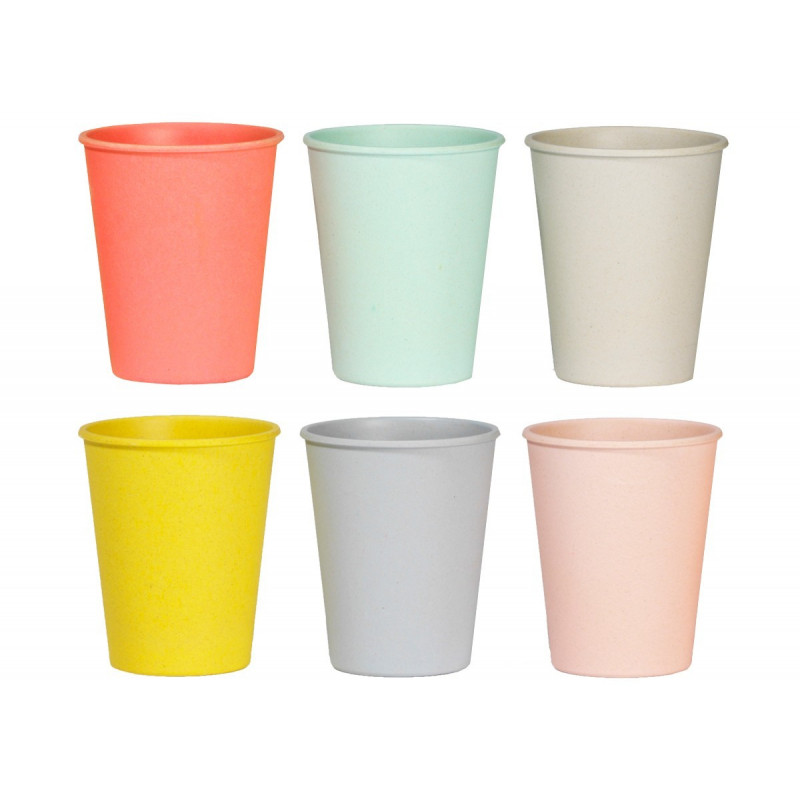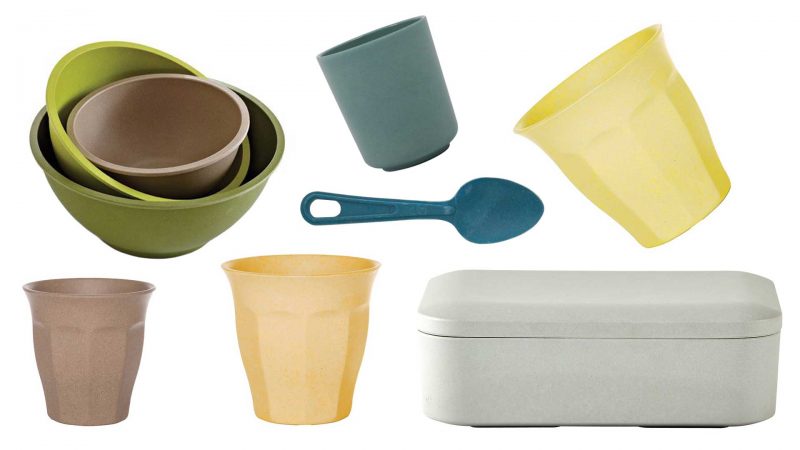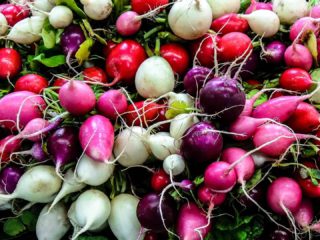You’ve probably seen examples of containers, cups, bowls and lunch boxes marketed as ‘made from bamboo’. They typically look and feel a lot like plastic, with brown fibre speckles and sometimes come in bright colours.
This interesting material is known by various names such as BPC or bamboo plastic composite, moulded bamboo, as well as a number of other trade names.
What’s it Actually Made Of?
Bamboo plastic composite is essentially bamboo fibre mixed with what we can refer to generally as plastic. To help us understand this material, we can think about it as being made of two constituent parts:
-Firstly, a bio based filler or reinforcer. In this case that filler is bamboo fibres.
-Secondly, a matrix, which we shall define as a substance that engulfs the fibres and holds them all in place. In this case the matrix is often an epoxy resin, which can be moulded and then hardens when set. Epoxies are polymers and in more broader terms, can be classed as plastics.
Note that it is possible to mix the natural bamboo fibres with other natural or synthetic fibres, such as glass fibres, in order to enhance certain properties of the material. It is also possible for various other types of plastic to be used as a matrix. Often, chemical additives are included to give the composite material desirable properties, specific to its intended use case e.g. durability, stiffness, reaction to heat etc.
The two constituent parts are typically mixed together and heat and pressure is applied. Chemical reactions take place and once cured, a strong material with useful properties is formed. Additional chemical agents may be added to aid bonding. Materials that are made in this way are often more broadly referred to as composite materials or fibre reinforced plastic.
For a more in depth understanding of the chemical processes, we suggest researching how epoxy resins are made, Wikipedia is a good place to start.
For a basic explanation of composite materials in general, check out this video.
Back in The Day
To add some context, the idea of combining epoxy resin with a filler is not new. Bakelite is an early 20th century example of a similar composite material. Its discovery is credited to Leo Bakeland who patented it in 1909.

Bakelite or, get ready for it; polyoxybenzylmethylenglycolanhydride, was the first mass produced synthetic plastic, made by mixing phenol and formaldehyde under heat and pressure (to create a resin) and adding a filler such as wood flour or asbestos. This material was quite revolutionary at the time. Bakelite’s low heat conductivity and strength, resulted in it being used for kitchenware products, as well as many other applications.

Oh and yes you did read correctly, bakelite was sometimes made using asbestos. This could be very hazardous to factory workers, much more so than to the end user. This is because during manufacturing, it was often in a form where asbestos dust could be inhaled.
The word formaldehyde, may also set alarm bells ringing for some of you, understandably. However, it is important to understand that although this substance is indeed classed by the World Health Organisation as a carcinogen above certain levels, the safety of formaldehyde is complicated. Formaldehyde is a naturally occurring organic compound that is essential for the functioning of human and mammalian metabolisms. Like many things that are essential to human bodily function, such as salts for example, a small amount is essential, however too much can be very harmful.
Let’s fast forward a century or so after the invention of Bakelite, to the present day, where we are now seeing a similar technique used to make bamboo plastic composites. These composites are often made from an epoxy resin mixed with bamboo fibre dust, with the bamboo acting as the fibrous filler. The bamboo fibres enable the material to be lightweight and relatively strong. The use of bamboo fibres as a filler is typically why bamboo plastic composites are often seen as an eco friendly option.

This video gives an overview of a small and simple bamboo composite factory setup. In this particular example bamboo fibres are being mixed with the plastic resin polypropylene. Polypropylene is a plastic that you’ve probably heard of and you almost certainly own something made of it. It’s used to make food containers, toys, car parts, electrical components and thousands of other everyday items.
Eco Friendly Can Mean Many Things
We shall only consider two main concerns in our assessment of whether bamboo plastic composites are eco-friendly:
-Biodegradability
-Safe disposal
Other significant considerations should be noted, but we shall perhaps discuss these in a separate article, simply because there would be too much to cover in one blog post. They include:
-Health concerns. In this context, this mainly relates to which chemicals are used during the production of composite kitchenware and how certain chemicals can react to heat and acidic foods. Bamboo plastic composites are used in other industries too, such as building materials and each use case has its own unique concerns.
-Fossil fuels as a source material for the chemicals required to make plastic. Because we do not consider fossil fuels to be renewable (on a human timescale), there is a case to be made for the use of ‘bioplastics’. This is where the constituent chemicals used to make plastics are extracted from crops instead of from petroleum. This is also a complex subject and deserves to be explored separately.
-Environmental pollution resulting from production methods. The entire supply chain and production methods are always relevant to the “eco credentials” of the end product. But again, due to complexity, this topic deserves to be considered separately.
So is Bamboo Plastic Biodegradable or Not?
Well, kind of, partially and sometimes. From a consumer perspective, it is very difficult to know exactly which epoxy resins, plastics and other chemicals have been used in the bamboo plastic composite manufacturing process. Therefore, it is not always straightforward to assess the true biodegradability of individual products.
The bamboo fibre part can be considered as biodegradable, although being mixed with epoxy resin could slow the process, compared to untreated bamboo. Various types of epoxy resins can be mixed with bamboo fibres to create a composite material. Some resins we may consider capable of biodegrading safely and some we may not. The initial difficulty then, is knowing exactly which resins and additives have been used during the manufacturing process.
When we know exactly which chemicals have been used, we can make a judgement about whether a bamboo composite can be thought of as more or less biodegradable than other plastics. This depends on:
-How long does it take to biodegrade?
-What conditions are required for biodegradation to occur?
-Are hazardous byproducts released during the biodegradation process?
The Science

Let’s look at a some examples. Some of the existing research into the biodegradation of epoxy resin seems fairly nascent and there is still much to learn. We came across numerous studies conducted under varying conditions, where some epoxy resins tested, appeared to be biodegradable. For example, PLA based resins are known to biodegrade under the right conditions. But one thing seemed to be clear: there is no one-size-fits-all solution when it comes to the biodegradation of resins or most other plastics.
This is partly because the biodegradability of any given substance, depends on the environment it is left to biodegrade in. Factors such as temperature, weathering and which types of micro organisms are present in any given environment, are important. Something that biodegrades rapidly in open air may not necessarily degrade in the same way under land fill or underwater. Products may need to be commercially composted in order to ensure that the conditions are suitable, to enable the item to biodegrade.
In one particular example, a study published in the International Biodeterioration & Biodegradation journal, appears to have shown signs that micro organisms were breaking down an epoxy in a test environment, where oxygen was available. After 15 days of exposure to the test environment, where specific types of microorganisms were present, the epoxy tested lost ~34% of its weight, the breakage and formation of chemical bonds was detected and the number of microbes appeared to increase. This suggests that the epoxy may be being used as a food source by the microbes and therefore biodegradation could be considered to be taking place, under these conditions. This particular study can be found in Volume 63, Issue 5.
Pros and Cons
PROS
-Bamboo itself is a renewable filler and can be farmed sustainably.
-Bamboo itself is biodegradable.
-Less “plastic” is used in the production process of bamboo plastic composites, compared to traditional plastics. The total amount of epoxy resin / plastic required to make each product is reduced, because the bamboo fibres make up a significant percentage of the overall composite material. e.g. 40% bamboo, 60% plastic.
-Some epoxy resins / plastics are considered biodegradable i.e. can be broken down by natural processes and consumed by micro organisms, under the right conditions.
-It is possible to make the plastic constituent have a lower overall environmental impact by using so called bioplastics. This is where the base chemicals required to make the plastic part, are extracted from crops.
-The overall production process of bamboo plastic composites can theoretically be conducted in a more sustainable way than traditional plastics. There are many reasons for this, right down to the fact that these composite products weigh less, therefore theoretically less fossil fuels need to be burned when transporting them.
CONS
-Using bamboo fibres as a filler in a composite material, does not necessarily make a product entirely biodegradable.
-“Plastic” is still used to produce composite materials. The bamboo is only a constituent part.
-Some composite products are made from types of epoxy resins and plastics that are not considered biodegradable.
-It is difficult for consumers to know which exact variety of resins and additives have been used in a product. Manufacturers and brands can be reluctant to publicise the exact chemical recipes of composite materials.
-The epoxy resins and other plastics that biodegrade acceptably in one environment, may not biodegrade in another. To ensure the correct environment for the product to be broken down, industrial composting may often be required.
-Industrial composting facilities may not be available or accessible for many consumers. Infrastructure that streamlines the disposal process of domestic waste for industrial composting, is uncommon, at the time of writing.
-At this stage, bamboo plastic composites probably do not represent a complete or fully functional solution to our plastic waste problems. Although they could potentially help mitigate them.
To Buy Or Not To Buy
There are many variants of this bamboo plastic composite material and candid information is not always available on each variety, for consumers. The exact mixture of chemicals used in the production of composite plastics is difficult to know. It is hard to be certain that a product contains the very specific mixes of particular types of epoxy resin and additives that would mean we can consider the final composite material, completely biodegradable.
We did find some evidence that certain varieties of bamboo plastic composite products, could in theory be considered biodegradable. Although this very much depends on the environment that they are disposed into. It therefore also depends on how you choose to define biodegradability. Most products probably won’t biodegrade in a reasonable time frame in landfill or in the ocean. But some can biodegrade when disposed into industrial composting facilities.
It is also worth noting here, that some bamboo plastic composites can be recycled rather than simply broken down. However this also requires very specific recycling facilities, that are currently uncommon. You can’t just throw this stuff into your household plastics recycling bin because it would contaminate the other plastic types.
There is a partial sustainability argument to be made, which goes something like this; using a product made of 40% bamboo fibres, is more sustainable than using a product that is 100% plastic, because it results in less plastic waste overall. In some ways this could be a valid point. Although it doesn’t completely solve the plastic problem, it could potentially help reduce it to some extent. It seems clear that plastic production of some type will continue for years to come, due to demand for its utility, profitability, the inertia of the industry and the varying regulatory approaches globally.
Ask Yourself This
So, can we be 100% sure that the bamboo lunch box we have our eye on is actually an eco friendly choice? Unfortunately not without witnessing the manufacturing process or lab testing the product. We would also probably need to make sure we have access to the appropriate industrial composting facilities too.
This means that in order to feel comfortable that our bamboo plastic kitchenware is really worthy of being called eco friendly, we probably need to consider three things:
-Do we have access to industrial composting?
-Do we know and understand exactly what substances the manufacturer has used to create the composite material that the product is made from?
-Are we clear on exactly what is meant when one of these products is referred to as ‘eco friendly’?
So in conclusion, yes you will have to weigh the pros and cons and ultimately make up your own mind on a case by case basis with this one! If you’ve made it this far, you’ll probably realise that there is much more that could be discussed on this subject, but hopefully our brief analysis has been informative, entertaining and a gateway to some further learning.
Disclosure
At the time of writing neither the author or the Pandabode brand owner have any direct financial interests in bamboo plastic composite products or companies. We do sell eco friendly products under the Pandabode brand and we regularly research interesting materials during our product design process, in order to identify opportunities where we can utilise suitable materials that satisfy the strict environmental criteria that we demand of all our products.
Sources
Paper – Recent Advances in Applications and Uses of Bamboo Fibres on Composite Materials
Paper – A review on Biodegradability of Hybrid/Glass fiber polymer composites
Paper – The Effects of High Temperature on Epoxy
Paper – Review of The Tensile Properties of Bamboo Fiber Reinforced Polymer Composite
Paper – Advanced High Strength Natural Fibre Composites
Book – Composites Part B: Engineering
Article – Journal of Cleaner Production
Brand – Composite Product Information
Article – Journal Vol.63 Issue 5: International Biodeterioration & Biodegradation
Paper – Comparative in-vitro biodegradation studies of epoxy and its silicone blend by selected microbial consortia
Article – Looks Like Plastic, Made of Moulded Bamboo
Wikipedia – Occasionally inaccurate, usually informative, always treasured 🙂
Video – Composite Materials by JEC
Video – Making Bamboo Plastic Composite











